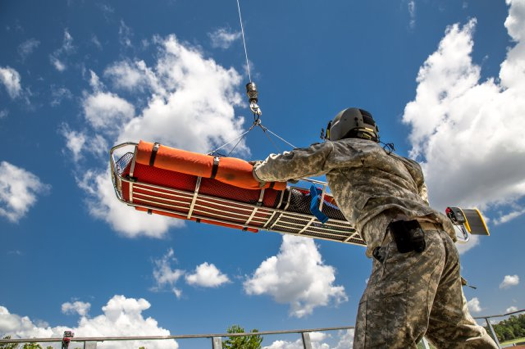
A U.S. Army medic participates in a mock rescue mission to test an anti-rotational device for possible future use in medevac missions. U.S. Army Photo
Medical evacuation operations are very complex and dangerous for evacuation helicopters, crewmembers, and patients. Medevac missions consist of retrieving the wounded from a dangerous environment and transporting them to medical triage or a medical treatment facility.
In the event that a helicopter cannot land, medevac crewmembers are trained to send down a medic, who evaluates and packages the patient, and to then use a rescue hoist device to lift the medic and patient into the aircraft.
One complication of medevac hoist operations is the uncontrolled spinning of the stretcher at the end of the hoist cable. This spinning can cause harm to the medic and patient.
Medical equipment, like hoist cables and stretchers, used aboard an aircraft must be tested and evaluated for aircraft compatibility to improve products or techniques that may reduce risk and increase efficiency of medevac missions.
Scientists and engineers with the U.S. Army Aeromedical Research Laboratory, or USAARL, Enroute Care and Airworthiness Division and Flight Systems Branch here, recently tested an anti-rotational device that, when used on a hoist cable, is intended to reduce the spinning of a load when lifted from the ground to the helicopter. The purpose of the test was to observe how the device interacted with the rescue basket and hoist system during helicopter transport over open terrain, an urban environment, and a ravine. USAARL also tested the tagline hoist that is currently used in many hoist missions and compared the performance of the tagline hoist to the performance of the anti-rotational device.
USAARL conducted the mock rescue hoist missions using an HH-60M medevac helicopter, an Army medic trained in hoist operations, a rescue basket, and an anthropomorphic test device or crash test dummy that was wearing a standard rucksack. Each hoist configuration was tested at 40 feet over open terrain, at 80 feet over an urban terrain, and at 100 feet over a ravine. During each test scenario, the Enroute Care and Airworthiness Division assessed the safety, usability, and effectiveness of the anti-rotational device in comparison to the tagline hoist.
“USAARL develops, tests, and evaluates performance solutions within the military environment,” said David Jones, a USAARL test manager assigned to the Enroute Care and Airworthiness Division. “Testing equipment is one of the ways we contribute to preserving the health, safety, and performance of the warfighter.”
After data collection is completed, analyses will be conducted to verify whether the anti-rotational device allows for a safer and more efficient hoist mission than standard hoist techniques. Results may be used to determine if the tagline currently used for hoist operations should be replaced with the anti-rotational device.









